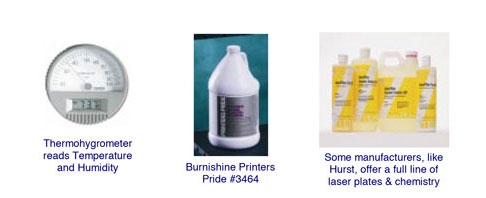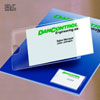Troubleshooting Laser Plates
Laser plates are supposed to be the greatest boon to offset printing since the introduction of the presensitized plate. Think of the advantages – no camera or film, no chemicals, no stripping, no plate burning or processing and all too often, no production. The plates DO work, but there is a learning curve involved. Fortunately, the curve is not too sharp and the slope is gentle. It is worth the effort to learn about laser plates in order to run a first-generation, computer-to-plate on your duplicator press. All of the laser plates offered by Lithco – Lithco Laser Plates and X-Plates, and Hurst SmartPlate™ and SmartPlate Xtreme all function similarly and troubleshooting them is also the same.
LASER PLATES ARE HUMIDITY SENSITIVE
The surface of a laser plate is water sensitive, just like the non-image area of an aluminum plate. If the plates dry out, certain problems can suddenly appear with a box of plates that had been running perfectly fine the prior day. Fortunately, the problem is easy to correct. Here is what you should look for and how to make corrections.
When the plate dries out, an excess of static electricity from the laser printer drum charges the plate more than is required to accept a normal amount of toner. Two things can happen. The first is general toner scatter, sometimes not readily visible to the naked eye. This fine distribution of excess toner will pick-up ink and print copy with little specks of ink all-over. The second is toner scatter around large image areas (including bold type) that appears as a "ghost image". If you see the toner scatter on your plates, the plate cleaner recommended by the plate manufacturer can remove it. To prevent the scatter from happening, you need to hydrate your plates by one of several methods.
SOLVING THE PROBLEM
Adding moisture to the environment around your laser plates will eliminate the problem and give clean, sharp printing plates. Here are a couple of simple ways to accomplish this. One of the easiest is to place a small humidifier in the room where the plates are stored and used, preferably near the feed tray on the laser printer. If you don't have a humidifier, try a small pot of water and a fan. Set the pot out of the way and put the fan behind it, so that it blows moist air toward the laser printer. These methods work well in areas with lower ceilings. In an industrial area with high ceilings, try dampening a press clean up sheet with water (damp, not dripping wet) and place it across the feed tray on the laser printer. This will create a high humidity directly around the plates, without actually getting them wet. This would be a perfect application for Thermohygrometers.
LASER PLATES DON'T LIKE ALCOHOL
If you have tried laser plates on your press with an alcohol-type dampening system (using alcohol) and experienced immediate toning, the alcohol is the problem. Laser plates and alcohol are incompatible. Try running an alcohol replacement in your fountain. Most alcohol replacements do not adversely affect laser plates. There are several good fountain concentrates on the market that have been designed alcohol-free to run with laser plates. You might consider trying Burnishine Universal SM Plus #3464, Hurst SmartPlate™ Fountain Solution 390 or Nikken PP Clean H Etch #71.

EXPECTING TOO MUCH
Every plate, regardless of type and manufacturer, has limitations. These limitations include run length, line per inch (LPI) dot resolution, dot size, compatibility with halftones or the ability to run with certain inks. Over the years, we have learned to accept these limitations on metal plates and black camera plates. Why can’t we do this for the laser plate?
THEY ARE LASER PLATES, NOT MAGIC
Many printers feel that if they can print the image on a sheet of paper, then they can print the image on a laser plate and it will run. To a degree, this is correct. The questions become how long will it run and how well? A better test to determine whether or not a laser plate will run well is to print the image on paper and then consider if it will make a good black camera plate. The limitations of laser plates and camera plates are very similar. As a rule of thumb, the plate has a limitation of about 85 LPI and will not hold a dot smaller than 5%.
PLATE STRETCH
Laser plates have a tendency to stretch on the press. This plate stretch creates problems when running close register work, especially when dealing with a T-51 head. You may not be able to totally eliminate plate stretch, but you can certainly minimize it with Lithco PlateStrips™. These adhesive-backed aluminum strips adhere to the lead edge of the laser plate. When you punch the plate, the aluminum strip prevents the holes from stretching out during the run. The plate itself, however, may still have some stretch in it.
WATCH YOUR PRESSURES
The image on a laser plate is fused toner. It is durable, but not indestructible. Excessive friction and/or pressure from the ink and water form rollers or the blanket can cause premature breakdown of laser plates. You will first lose the fine dots, then type starts to look ragged at the edges and finally solids become streaked or splotchy. Run with the minimum pressures needed to get the job done.
INK
Another factor that causes premature plate breakdown is improper ink. Ink that is overly abrasive or very tacky will destroy a laser plate in short order. Two different problems occur here. First the ink attacks the image, eroding away fine dots, lines and the edges of solids. Secondly, excessive tack will cause the background to tone over (not enough water in the ink). Although not an absolute, try to keep the tack of the ink at 14 or under, but remember that you don't want soup either.
LET'S BLAME THE PAPER – EVERYONE ELSE DOES
Once and a while, it is the paper's fault. Our bright white papers are no longer chlorine bleached. They are made white by coating them with calcium carbonate. Calcium carbonate is an alkaline substance that is only slightly soluble in water. It builds up on blankets and rollers and can form deposits hard enough to scratch the image not only on laser plates, but on aluminum plates as well. Calcium carbonate is not soluble in conventional blanket and roller washes. You need to use a specialty cleaner such as Varn Calcium Eliminator.

Other products and companies referred to herein are trademarks or registered trademarks of their respective companies.
**Prices, images and specifications subject to change without notice.**


For your convenience, we accept these credit cards:











